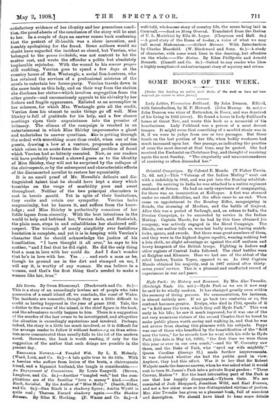Hyde Park : its History and Romance. By Mrs. Alec
Tweedie. (Eveleigh Nash. 15s. net.)—Hyde Park as we see it now may be said to be wholly modern. It has changed greatly even within the memory of living persons. Its ornamentation, for instance, is almost entirely new. If we go back two centuries or so, the contrast becomes greater. Evelyn, who died in 1700, speaks of it as "a field near the town, which they call Hyde Park." This was early in his life; he saw it much improved, for it was one of the not very numerous virtues of the second Charles that he loved to make public places worth seeing and walking in, and that he was not averse from sharing this pleasure with his subjects. Pepys was one of those who benefited by the beautification of the "field near the town," for he records how he went with his wife to Hyde Park (the date is May 1st, 1669), "the first time we were there this year or ever in our own eoach,"—and Sir W. Coventry saw them, and the Duke of York, who "eyed my wife mightily." Queen Caroline (George II.) made further improvemeate. It was doubted whether she had the publics good in view. Anyhow, they had this effect. Was it to her that .Sir Robetit Walpole made the famous answer, when he was asked what it would coat to turn St. James's Park into a private Royal garden : "Three Crowns, Madam" ? Not the least interesting part of the Park is one that has happily disappeared,—Tyburn Gate. We are reminded of Jack _Sheppard, Jonathan Wild, and Earl Formes, and not a few other mesa or less distinguished victims of justice. Airs. Alec Tweedie has given us a pleasant book, full of aneedoto and description. We should have liked to hear more details
about the Serpentine. It was once a famous haunt of fish. The largest perch on record (nine pounds) is said to have been caught in it.









































 Previous page
Previous page